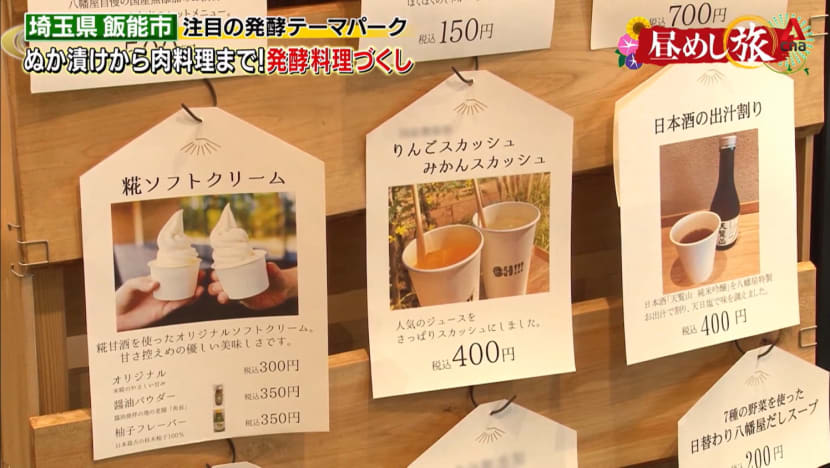It's Lunch Time - Saitama Prefecture part 1
This week's highlights include a unique theme park in Hanno City in Saitama Prefecture which focuses on different types of fermented foods and a canoe workshop near a man-made lake in the mountains.

This week, we visit Saitama Prefecture to find out what the locals eat. Our first stop is Hanno City. Popular specialities here include Bushu Hanno udon and misozuke manju. In October 2020, a unique food theme park opened in Hanno. Called “OH! Fermentation, Health and the Magic of Food”, it is about 10 minutes away by bus from Hanno Station and has several restaurants selling fermented food. For example, the restaurant Femy is popular for dishes made with fermented seasonings. They include grilled black Japanese beef steak, which is marinated in soy sauce, malted rice and Japanese pepper, and sauteed chicken marinated in salted malt. Piene Cafe serves items like malted rice amazake with vegetables. The amazake is fermented only with rice malt without sake lees. Its most popular dessert is cheese brulee tart, which has a malted rice amazake cheese cream layer and a custard cream layer. Yawataya sells carefully selected fermented foods from all over Japan.
We meet Shiho Tanaka, a 28-year-old girl from Niigata who loves fermented food. She works for OH! Inc and tells us that fermented food is gaining popularity, especially since people are becoming more health conscious. She shows us some of the popular products sold at the facility. They include pogi kimchi, which uses a sauce made with chilli pepper, fish sauce and millet sugar. The OH! facility is run by Pickles Corporation, which specialises in fermented food and pickles. Its head office is in Tokorozawa. The company chose Hanno as the location for its theme park as it is rich in nature and fresh vegetables are easily available.
About 800 types of fermented foods are sold at the store, including 20 kinds of soy sauce from all over Japan, salted and fermented chicken liver from Oita and quail eggs marinated in soy sauce. Pickles made from cucumbers, carrots, radish, sweet potato and mushroom are also popular. The facility also sells a product used to make pickles from fresh vegetables. It is sold in a tube and is called Kantan Nukadoko. It can also be used to marinate meat and pickle fruit. For example, pickled grapes are quite popular.
The store has a section where people can eat. A wide range of dishes and desserts made from fermented foods can be found here. Examples are kimchi croquette made with minced black Japanese beef and wood-fired black beef served with a sweet onion sauce made with soy sauce and malted rice. There is also soft-serve ice cream made with malted rice.
We to order a dish which comes with different types of pickles, such as pickled plum, fukujinzuke, pickled vegetables made with millet sugar, spicy Gohan ga Susumu Kimchi, okaka ginger, bonito flakes marinated with soy sauce and ginger, pickled yam, pickled cucumber and sesame hijiki. We are also served fermented brown rice with soup stock made from dried bonito flakes and seven kinds of vegetables, including cabbage and burdock.
Ms Tanaka tells us about a facility called Pari-Shaki Laboratory, where she conducts a kimchi-making workshop. Participants can use seasonings and ingredients of their choice to create their own flavour. We join the workshop and make our own Gohan ga Susumu Kimchi, using ingredients such as pickled Chinese cabbage, bonito flakes, Korean chillies, marmalade, kelp and dried squid.
After the workshop, Ms Tanaka shows us her lunch box. It includes rice balls with ginger miso paste, sauteed shimeji mushrooms in butter with malted rice and yuzu pepper, and malted rice amazake salad. We go to her house to see how she uses fermented foods or fermented dressings in her daily cooking. She makes a salad with paprika and carrots. For the dressing, she mixes carrot-flavoured malted rice amazake with olive oil, lemon juice, salt and pepper. Another dish, tomato wrapped in pork meat, comes with a fermented sauce with malted rice in it.
Our next destination is a man-made lake in the mountains. Lake Naguri has a 4.5-kilometre promenade around it. This time, we visit Naoyuki Yamada, who lives by the lake. He is a sculptor by profession but later started to build canoes. He now owns a canoe workshop where he makes and sells them. He has been canoeing for 40 years and teaches customers how to build them. Customers would buy a kit for 10,000 yen and it takes a minimum of 30 sessions to complete a canoe. Mr Naoyuki has taught more than 600 people how to make canoes.
He agrees to show us his meal so we head to his house, five minutes by car from the workshop. We meet his wife Mrs Yamada; they have been married for 43 years. For dinner, she makes simmered butterbur, fried tofu and pickled vegetables, gyoza dumplings, boiled spinach, vinegared mackerel and raw salmon. She also stir-fries yam with pork, seasoning it with light soup stock, sake, salt and pepper.
Tips:
1) Bushu Hanno udon and misozuke manju are popular specialities of Hanno City
2) Visit a unique theme park in Hanno City which focuses on fermented food












